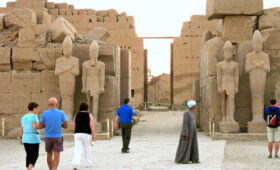Egypt’s UNESCO World Heritage Sites Explained
Egypt is a land steeped in history, mythology, and architectural marvels. Its importance to world heritage is reflected in the number of UNESCO World Heritage Sites it holds ,each a testament to the grandeur and complexity of ancient Egyptian civilization, Islamic culture, and natural beauty.
In this guide, Mandari Travel breaks down Egypt’s UNESCO sites, why they matter, and how you can explore them on your next journey through this timeless land.
1. Ancient Thebes with Its Necropolis
Location: Luxor
Once the capital of ancient Egypt, Thebes is home to the Karnak and Luxor Temples, and the famed Valley of the Kings and Queens.
Why It’s UNESCO-Protected:
- Burial place of pharaohs including Tutankhamun and Ramses II
- Architectural marvels that span the New Kingdom era
- Invaluable insights into religious, political, and artistic practices
Mandari Travel Tip: Explore Thebes with a certified Egyptologist on our multi-day Luxor tours for deeper historical context and hidden tombs.
2. Historic Cair
Location: Cairo
Cairo isn’t just Egypt’s capital ,it’s a living museum. Historic Cairo includes Islamic landmarks like the Citadel of Saladin, Al-Azhar Mosque, and ancient streets of Khan El Khalili.
Why It’s UNESCO-Protected:
- One of the world’s oldest Islamic cities
- Remarkably preserved architecture, art, and culture from the 10th–19th centuries
- Rich in Coptic and Islamic heritage
Mandari Travel Tip: Our walking tours of Historic Cairo include mosque visits, old markets, and hidden alleys filled with stories and history.
3. Memphis and Its Necropolis – Pyramid Fields from Giza to Dahshur
Location: Greater Cairo area
From the Great Pyramids of Giza to the Step Pyramid of Djoser in Saqqara and the Bent Pyramid in Dahshur, this site covers ancient Egypt’s royal burial evolution.
Why It’s UNESCO-Protected:
- Home to the oldest pyramid ever built (Djoser’s Step Pyramid)
- Architectural and engineering innovations that shaped ancient Egypt
- The majestic Sphinx and Pyramid of Khafre
Mandari Travel Tip: Book our Pyramids Day Tour to visit Saqqara, Giza, and Dahshur with private transport and expert guides.
4. Abu Mena (Currently Endangered)
Location: Near Alexandria
A 4th-century Christian pilgrimage site, Abu Mena includes a basilica, monastery, and other sacred buildings. The site is currently endangered due to groundwater damage.
Why It’s UNESCO-Protected:
- One of the earliest Christian monastic complexes
- A key example of early Christian architecture in Egypt
Mandari Travel Tip: Combine a trip to Abu Mena with a tour of Alexandria for a full-day coastal experience.
5. Wadi Al-Hitan (Whale Valley)
Location: Western Desert, Fayoum Governorate
Not all of Egypt’s heritage is man-made. Wadi Al-Hitan is a fossil-rich desert site where the remains of ancient whales offer evidence of evolutionary science.
Why It’s UNESCO-Protected:
- Contains fossils of the earliest whale species with legs
- A rare window into the Earth’s prehistoric marine life
- Stunning desert landscape and eco-tourism potential
Mandari Travel Tip: Experience Wadi Al-Hitan and Fayoum with a desert safari and overnight eco-lodge stay , perfect for families and adventure lovers.
Explore Egypt’s Heritage with Mandari Travel
UNESCO World Heritage Sites are not just places to see , they are places to feel, learn, and connect with humanity’s shared history. Mandari Travel offers expert-led tours to each of these sites, ensuring you understand their full significance and enjoy them in comfort and safety.
Email: info@mandaritravel.com.com
Call/WhatsApp: +255 750 900 811
Fill out the form below to request a quote or book your customized Egypt heritage tour today!




